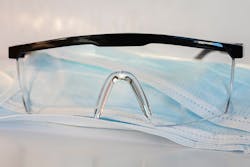The COVID-19 pandemic has turned the world upside down in so many ways. I don’t know of a single collision repair operator who has not been affected by the spread of the virus and/or the response to control the spread. As a more than casual observer of human behavior, I have noticed the varied reactions to the “Safer at Home” directives and the wash-your-hands and wear-your-mask requirements.
Perhaps you have seen groups of people in your community and in your shop give pushback to the orders and advice, while another group begrudgingly adopts the changes and adapts to the new requirements. It reminds me of the positive and negative responses that existed around the imposition of seat belt laws and the requirement to wear a helmet when riding a motorcycle. I believe the overarching theme of these new requirements is that of safety, just like the now-accepted requirement of seat belts. This, in turn, made me think a little more deeply about general safety in our workplace.
Our team members now work at a distance from each other. They do not congregate in break rooms or take lunches together. Employees wear masks and we require that customers and other visitors to the shop wear masks as well. All of this is an obvious and highly visible conformity to safety standards designed to protect us all from illness. Something that’s getting lost in all the commotion is the opportunity to create new, or to reinforce existing standards of safety behaviors at our shops.
Now is a great time to build and implement a plan for ongoing safety, because all of us have a heightened regard for safety measures and best practices, whether we like them or not. Often, where there is awareness there’s less resistance and more acceptance. If you do not already have written and enforceable safety procedures in your shop, I would suggest getting in touch with your workers’ compensation insurance broker or insurance company. Such agencies and companies have people on staff who are risk managers--someone who can come to your shop and assess your safety programs or help you create a new one. Some larger companies have helpful online videos that can teach you some of the best ways to implement a safety program.
If you already have safety standards in place, you should still connect with your workers’ comp insurance company risk manager to review them. They should be able to shore up your standards and fill any gaps. I’ve worked with risk managers over the years to upgrade and improve some of my own standard operating procedures related to safety, and here are some examples of what I learned.
There are many studies done to rank the frequency and types of injuries in collision shops. In general, the top three are strains/sprains, lacerations (a fancy name for cuts), and contusions, which are bruises that result from impacts to the body. The lists often go on to include eye injuries from flying debris and respiratory issues from exposure to toxins and particulates.
For decades, I’ve dealt with several instances of eye injuries to employees who were grinding or hammering a sheet metal panel, or working nearby someone who was. The eye injuries were usually caused by little pieces of metal that were embedded in the eye. It was troubling to me that sometimes these injuries would occur even though the technician was wearing safety glasses. What did I learn from insurance company risk managers about these eye injuries?
Believe it or not, we were issuing the wrong type of safety glasses to our team members. It turns out that safety glasses are not as effective as safety goggles at preventing flying pieces of metal from getting into one’s eye. A lot of safety glasses are just like regular glasses--they don’t have any shields on the sides of the lenses. This means that flying debris can pass inside of the glasses. The simple fix was to issue safety glasses with side protection, or to just issue safety goggles instead.
There have been many suggestions from risk managers that I have been able to implement with positive results. Another suggestion that works well is to have monthly safety meetings for all team members on a specific topic. Some worker’s comp insurance companies have safety and prevention videos you can watch online as a team. They’re short but clear and are a great visual learning experience. The videos and other resources are all about preventing injuries to the head, shoulders, knees, and toes, and everything in between. They are well worth the 15-minute investment in advancing your safety awareness.
One final thought on some best practices for enhancing your safety systems. Part 1 of the system is to address any injury, no matter how slight, with immediate urgency. If you can align yourself with a local clinic or hospital that can examine and treat injuries that fall into the “first aid” category, do it now. Your workers’ comp company may already have recommendations for which clinics or hospitals are set up for treating first aid injuries, rather than having them unnecessarily classify them as workers’ comp injuries.
Part 2 of the system, and this is crucial, is to have someone in leadership at your shop who takes the injured team member to the clinic and remains there until the first aid is rendered, who then takes the employee back to work. If this does not demonstrate that you care about the well-being of your team, I don’t what does. Make it a habit to take the employee to any follow up appointments as well. The goodwill and trust you generate will pay massive dividends to your culture. And even though you can’t see it because everyone is wearing a mask, there’ll be smiles for you from your team.
See you next month.





